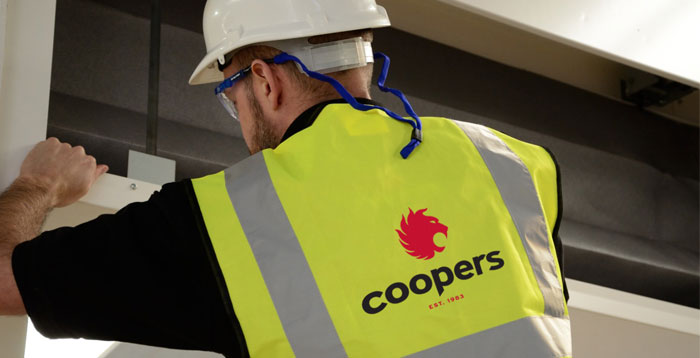Fire Curtain Servicing: Specifications and Maintenance
Whether you’re a retailer, facilities manager or a domestic homeowner, ensuring that your fire and smoke curtains remain fully operationally is critical for keeping your occupants protected from the effects of fire. It is also essential for your building’s compliance with fire regulations and insurance requirements and fire curtain servicing is the only way to assure that this is the case.
When fire curtains are used as part of a fire-engineered design solution, they become a critical element of that design. As a result, should a fire curtain fail to deploy to its operational position, the fire-engineered design solution would be compromised and the building and its occupants would be in danger.
This is recognised by BS 8524-1: Active fire curtain assemblies specification, which outlines requirements for the design, testing and classification of active fire curtain barrier assemblies. This standard also recognises that the maintenance of fire curtains, throughout their lifetime, is just as important as the initial specification.
In the same way the BS 8524-2: Active fire curtain barrier assemblies code of practice for application, installation and maintenance, offers recommendations for these actions .
Since, in the UK, the Regulatory Reform (Fire Safety) Order (RR(FS)O) places the responsibility on the building occupier to ensure that all fire safety measures are maintained, in an operational state, at all times, they need to maintain fire curtains, in accordance with manufacturer’s’ instructions. In addition building occupiers should follow the recommendations outlined in BS 8524-2 for fire curtain servicing, as infringements may lead to prosecution.
Fire Curtain Servicing: Onsite Fire Curtain Checks
BS 8524 requires that fire curtain servicing, planned inspections, testing and maintenance should be carried out by a ‘competent person who is able to check and confirm that barrier assemblies are operating and performing effectively, when required’ and that all such tests are accurately logged. Similarly, it recommends that maintenance, servicing and testing are conducted in accordance with the manufacturer’s instructions.
There are a series of regular checks recommended by the BS 8524. Some of these can be undertaken by the Responsible Person on site, others must be undertaken by a competent engineer as part of a planned maintenance programme.
As part of their regular risk assessments, building occupiers should check for obstructions that might prevent the fire curtain from deploying. They should also remember that changes to building layout or to the activities within it, could impact on the installed fire safety systems. For instance, if a wall has been moved or removed then the protection offered by a curtain may be affected.
At least monthly, and on escape routes weekly, the curtain should be operated. If it forms part of a smoke control system protecting a means of escape, the barrier assembly should be operated in conjunction with the smoke control system, at least every three months.
The BS 8524 also recommends that tests are undertaken at the same time each week so that all staff are familiar with the system’s operation. It recommends that all maintenance staff should be fully trained by the manufacturer. The building occupier should undertake a test, at least monthly, of self-closing devices and automatic release mechanisms via a test switch. They should also check that the sensory detection equipment and self-test facility is functioning correctly.
Fire Curtain Servicing: Professional Inspections
An inspection should be undertaken by a qualified engineer, at a minimum, annually. Coopers recommend a bi-annual inspection in domestic premises or small offices, and the same 6-monthly inspections for large installations such as shopping malls, apartment complexes, offices and retail spaces etc.
Fire curtain servicing engineers will check the security of fixings, mechanical parts and linkages to other systems, such as the fire alarm and smoke control systems and undertake a range of electrical checks. These include testing the power draw of motors; the charging capacity of batteries and their ability to hold charge and the operation of the brakes.
The batteries perform an essential role as they ensure that the system will operate in a power cut. Batteries are designed to last around two years, but this time, can be extended with regular fire curtain servicing.
Smoke seals also play a vital role. Older silicone seals were prone to vandalism and damage due to obstructions, but the more modern systems now use internal seals that are less prone to damage. Any replacement seals should be of the same formulation, dimensions and configuration as those recommended in the manufacturer’s fire test report and should be fitted in accordance with the manufacturer’s instructions.
Fire curtains are life-cycle products so, when specifying a system, it is essential to consider the whole package from quality, performance, installation and maintenance, to after sales care.
Fire Curtain Servicing From Coopers:
Manufacturers, such as Coopers Fire, offer specialist fire curtain servicing in their aftercare packages, tailored to your specific requirements. This is the best way to ensure that fire curtains will operate as expected in the event of a fire. While many general facilities management firms may offer contracts to maintain all systems and local service agreements that ensure a rapid response, many of these contracts do not take into account competence. While they may arrive quickly, they may be unable to solve the problem, as they will not have the necessary parts or expertise.
From PC World and the Shard to facilities management companies like Carillion and managing agents such as Lend Lease, Coopers service and maintenance engineers ensure that the fire curtains and smoke curtains installed maintain their effectiveness.
Coopers are the UK’s only fire and smoke curtain manufacturer approved by an Independent Third Party Accreditation to carry out the servicing of fire barrier curtains and smoke curtains. If you would like to know more, or to arrange a servicing visit please do get in contact.
get in touch
Contact Us
For further information on Coopers Fire’s range of vertical and horizontal smoke and fire barrier systems please feel free to call us at 02392454405 or email us.


